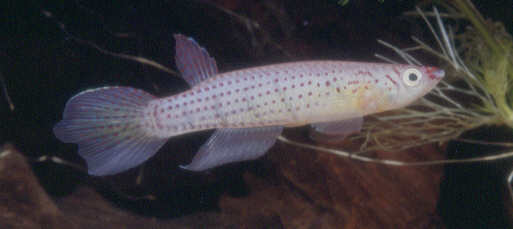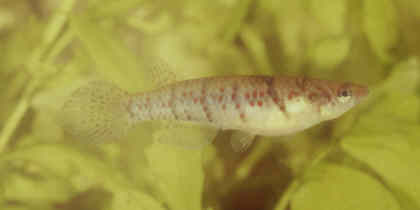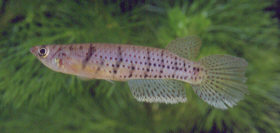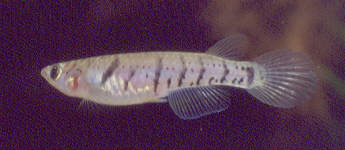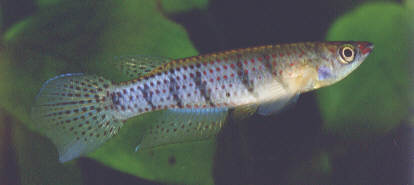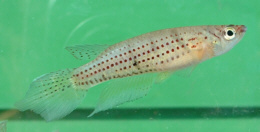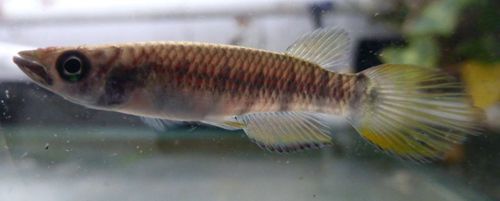Epiplatys grahami (Boulenger 1911)

E.grahami Benin. Wild male. Photo courtesy of Ed Pürzl.
| Meaning of Name |
After Dr. W. M. Graham, collector of the types. |
|||||||||||
| First Description |
Boulenger G. A. 1911. Descriptions of new African Cyprinodont fishes. Annals & Magazine of Natural History (8) viii (44): p 267. |
|||||||||||
| Size |
7 cm (Schultze 1937) |
|||||||||||
| Meristics |
|
|||||||||||
| Karyotype |
|
|||||||||||
| Sub-Genus |
Epiplatys |
|||||||||||
| Group |
singa |
|||||||||||
| Synonyms |
|
|||||||||||
Populations
|
Muyuka - Found in a commercial
import to the UK December 2022. I placed them in grahami
as all the fish had bright green eyes characteristic of the species.
Found in a bag of Procatopus similis
collected at Muyuka. Also in the bag a few pairs of A.ahli
& A.splendopleure.
|
|||||||||||
| Type Locality |
Lagos, southwestern Nigeria. The biotope was a swampy area. |
|||||||||||
| Distribution |
Found along coastal regions from southeastern Benin through to northwestern Equatorial Guinea. http://homepage.uibk.ac.at/homepage/c102/c102mr/epiplaty/grahami.htm |
|||||||||||
| Habitat |
Coastal swamps, swampy areas & swampy regions of small streams. Scheel observed that young grahami will schoal with young of sexfasciatus in coastal swamp areas but adults are found in 'swamp-forest'. |
|||||||||||
| Distinguishing Characteristics |
Distinguishing this species from sexfasciatus can be done by the eyes which are glass green whereas sexfasciatus are not. Preserved fish can also be seperated by the lateral line organs on the dorsal part of the snout which resemple Roloffia type in grahami & Aphyosemion in sexfasciatus. This is a 'spotty' fish much the same as E.singa from the Zaire River drainage. E.grahami can be seperated by there vertical dark bands & 'shiny green' eyes. |
|||||||||||
| Colour/Pattern Variability | This is a species with a fairly large distribution area. I have not seen sufficient photographic material to base an accurate judgement here. I have only kept populations from Lagos & Takon. | |||||||||||
| History |
This species was first introduced to captivity in 1905. They formed part of the very first shipment of killies for aquaria to come out of Atlantic Africa along with E.sexfasciatus, Fp.sjoestedti & Fp.arnoldi. Collected 'near the Warri' in the western Niger Delta. These were taken over by W.Schroot. Arnold originally identified the grahami as spilargyreius in 1906. Thumm, a member of the Wasserrose of Dresden, was the first recorded person to breed them in captivity. Köhler reported that grahami made up 12% of the grahami / sexfasciatus part of the import. Zimmerman crossed these two species & reported the young non-viable. Scheel, in 1962, also made similar crossing experiments with the same results. Thumm in 1909 did not agree with Arnold's identification & considered infrafasciatus a better choice, but this was not accepted. He sent 2 individuals to Boulenger for identification & he considered them as longiventralis. In 1911 Boulenger described Haplochilus grahami based on a collection by Dr.W.M.Graham in swamps near Lagos. This was used in 1912 in Germany but it was questionable if Boulenger's & the German import were the same species. Boulenger gives the following collectors / locations in his 1915 Catalogue.
In 1924 another import from the Niger Delta area arrived which Rachow identified as grahami. Pellegrin reported grahami from Ouesso on the Sangha River in 1925 but Scheel considered them not to be this species. Mayer from Hamburg had a species, in 1933, which
were identified as Haplochilus macrostigma
but could not have been this species as the import originated from Lagos,
Nigeria. Ulf Hannerz collected near Benin City in summer 1961. A single female E.grahami was collected in with E.longiventralis & E.sexfasciatus. In 1962 Clausen collected in Nigeria & Ghana some fish with 'shining eyes' collected with E.sexfasciatus in swamps near Lagos. Only 2 of this collection has these eyes & both were females. First reported introduction in the UK was about 1966. History of the synonym Panchax superbus Ahl 1924 Ahl described this sp. from a single
specimen presented by Stieler, collected in 'West Africa'. This dubious
origin of the type material went against there being accepted as a true
sp. They were placed closest to grahami
at the time of description.
History of the synonym E.nigromarginatus Schultze 1937 First reported from the aquarium society of Leipzig which used the name 'nigromarginatus'. Schultze stated that he received specimens from Scholze & Poetzsche who got them from West Africa in a location between Cameroon & Congo. He also reported that he thought Ahl had named this form already. In 1938 Ahl also described them & gave the indication of there originating from the Niger Delta. |
|||||||||||
| Breeding Notes |
I have had populations from Lagos as wild imports, & Takon. Both proved easy to breed. I did add about one teaspoon of salt per gallon. Eggs are laid in top & bottom mops with a preference for top mops. Eggs incubate in water for about 14 days. As the fry are small I fed the newly hatched with infusoria for a few days. Growth is quite fast considering the small size of the eggs with sexual maturity being attained around 5-6 months. An early import around 1970 was of a population just named 'Niger Delta'. These were a little difficult to breed & few eggs were seen. It was considered best to leave them alone & not disturb the tank any more than was necessary. The fry which appeared in the parents tank were removed to another tank with identical water conditions. Water conditions were, temperature 74°F, pH 6·8, DH 2. The synonym E.nigromarginatus was imported by the BKA around 1970 & reports suggested that parents would eat there fry, & eggs needed to be taken out of the breeding tank. Water conditions were not critical & the fish tolerated temperatures between 70-74°F. Young showed the first signs of sexing out at 12 weeks. |
|||||||||||
| Diameter of Egg | Small. | |||||||||||
| Remarks |
Scheel in ROTOW 1 considered that the throat markings of males play an important role in species recognition. Wildekamp (in 'A World of Killies Volume III') lists E.zenkeri as a synonym for E.grahami. I prefer to follow Huber in Killi Data & list them on this site as E.infrafasciatus zenkeri. |

